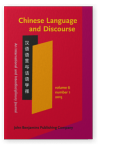On the principled polysemy of -kai in Chinese resultative verbs
The present study sets out to construct a semantic network for -kai in Chinese resultative verbs based on the framework of Principled Polysemy. Our analysis concerning the cognitive-pragmatic motivations for the meaning extensions of postverbal -kai pinpoints the significance of perspective-taking and real-world force dynamics in the conceptual structure of Chinese resultative verbs. With the aid of corpus data, we further demonstrate how pertinent textual cues help to disambiguate polysemous V-kai complex verbs and evoke metaphorical readings of the gestalt V–V constructions, hinting at the distributed and context-sensitive nature of the meaning construction of Chinese resultative verbs.
References
Croft, Williams, and D. Alan Cruse
2004 Cognitive Linguistics. Cambridge: Cambridge University Press.


Evans, Vyvyan
2005 “
The Meaning of Time: Polysemy, the Lexicon and Conceptual Structure.”
Journal of Linguistics 41 (1): 33–75.


Evans, Vyvyan, and Melanie Green
2006 Cognitive Linguistics: An Introduction. Edinburgh: Edinburgh University Press.

Givón, Talmy
1979 “
From Discourse to Syntax: Grammar as a Processing Strategy.” In
Syntax and Semantics, vol.121, ed. by
Talmy Givón, 81–112. New York: Academic Press.

Goldberg, Adele E., and Ray Jackendoff
2004 “
The English Resultative as a Family of Constructions.”
Language 80 (3): 532–568.


Hopper, Paul, and Elizabeth C. Traugott
2003 Grammaticalization (2nd ed.). Cambridge: Cambridge University Press.


Huang, Chu-Ren, and Shen-Min Chang
1996 “
Metaphor, Metaphorical Extension, and Grammaticalization: A Study of Mandarin Chinese –qilai
.” In
Conceptual Structure, Discourse, and Language, ed. by
Adele Goldberg, 201–216. Stanford: CSLI.

Huang, Su-miao, and Ching-yu Hsieh
2008 “
Grammaticalization of Directional Complements in Mandarin Chinese.”
Language and Linguistics 9 (1): 49–68.

Johnson, Mark
1987 The Body in the Mind: The Bodily Basis of Meaning, Imagination, and Reason. Chicago: University of Chicago Press.


Lakoff, George
1987 Women, Fire, and Dangerous Things: What Categories Reveal about the Mind. Chicago: University of Chicago Press.


Langacker, Ronald W
1987 Foundations of Cognitive Grammar, vol.11. Stanford, CA: Stanford University Press.

Langacker, Ronald W
1999 Grammar and Conceptualization. Berlin: De Gruyter Mouton.


Li, Charles N., and Sandra A. Thompson
1981 Mandarin Chinese: A Functional Reference Grammar. Berkeley, CA: University of California Press.

Liu, Mei-chun
1997 “
Conceptual Basis and Categorial Structure: A Study of Mandarin V-R Compounds as a Radial Category.” In
Chinese Languages and Linguistics IV: Typological Studies of Languages in China, ed. by
Chiu-yu Tseng, 462–473. Taipei: Academia Sinica.

Liu, Yuehua, Wenyu Pan, and Hua Gu
2004 Shiyong xiandai hanyu yufa [
Practical Modern Chinese Grammar] (Revised and enlarged edition). Beijing: The Commercial Press.

Lü, Louis Wei-lun
2001 “
Metaphorical Transfer and Pragmatic Strengthening: On the Development of V-diao in Mandarin.”
Computational Linguistics and Chinese Language Processing 6 (2): 1–10.

Packard, Jerome L
2000 The Morphology of Chinese: A Linguistic and Cognitive Approach. Cambridge: Cambridge University Press.


Palmer, Martha
2000 “
Consistent Criteria for Sense Distinctions.”
Computers and the Humanities 341: 217–222.


Peña, Sandra Cervel
1999 “
Subsidiarity Relationships Between Image-schemas: An Approach to the Force Schema.”
Journal of English Studies 11: 187–207.


Ross, Claudia
1990 “
Resultative Verb Compounds.”
Journal of the Chinese Language Teacher’s Association 25 (3): 61–83.

Sandra, Dominiek
1998 “
What Linguists Can and Can’t Tell you about the Human Mind: A Reply to Croft.”
Cognitive Linguistics 9 (4): 361–378.


Sweetser, Eve
1990 From Etymology to Pragmatics: Metaphorical and Cultural Aspects of Semantics Structure. Cambridge: Cambridge University Press.


Taylor, John R
2003 Linguistic Categorization (3rd ed.). Oxford: Oxford University Press.

Teng, Shou-hsin
1977 “
A Grammar of Verb-particle in Chinese.”
Journal of Chinese Linguistics 51: 1–25.

Thompson, Sandra A
1973 “
Resultative Verb Compounds in Mandarin Chinese: A Case for Lexical Rules.”
Language 49 (2): 361–379.


Traugott, Elizabeth C
1989 “
On the Rise of Epistemic Meanings in English: An Example of Subjectification in Semantic Change.”
Language 65 (1): 31–55.


Tyler, Andrea, and Vyvyan Evans
2001 “
Reconsidering Prepositional Polysemy Networks: The Case of over
.”
Language 77 (4): 724–765.


Tyler, Andrea, and Vyvyan Evans
2003 The Semantics of English Prepositions: Spatial Scenes, Embodied Meaning and Cognition. Cambridge: Cambridge University Press.


Wang, Ben Pin-Yun
2012 “
Usage Effects on the Cognitive Routinization of Chinese Resultative Verbs.”
Research in Language 10 (4): 405–422.


Cited by
Cited by 3 other publications
Lu, Wei-lun
2022.
A Conceptual Exploration of Polysemy: A Case Study of [V] – [UP] and [V] – [SHANG],

This list is based on CrossRef data as of 27 march 2024. Please note that it may not be complete. Sources presented here have been supplied by the respective publishers.
Any errors therein should be reported to them.
